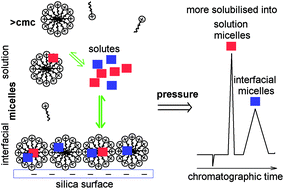Liquid chromatography with micelles in open-tube capillaries†
Abstract
The greening efforts in analytical chromatography are mostly on the reduction of chemical waste and the replacement of organic solvents used in the mobile phase. Here, we present a new green liquid chromatography approach in open-tubes with the following advantages and/or features: up to zero chemical waste, minimal use of reagents and samples, no preparation of a solid stationary phase, relatively fast separations and reproducible results. The approach was based on the molecular organisation of common long chain ionic surfactants (i.e., hexadecyltrimethylammonium bromide and sodium dodecyl sulfate) to form micelles in solution and at the solid surface-liquid interface. The differential solubilisation or distribution of solutes into these micelles produced the unexpected separation or retention of various types of molecules including aromatic hydrocarbons, anionic, cationic and amphiphilic drugs, pesticides, peptides and a small protein. Chromatography was done in 25–200 μm range inner diameter and 60 or 120 cm long fused silica capillaries against a flow of predominantly aqueous surfactant solutions above the critical micelle concentration as mobile phase. Distribution between these micelles was affected by the mobile phase conditions such as surfactant concentration, pH, salt concentration and organic solvent content used, which we harnessed to demonstrate sample enrichment. Analytical performance was assessed in the separation of pesticides and antioxidants and in real sample matrices. A comparison with reversed phase chromatography for the analysis of a drug combination was also done. This important fundamental behavior of surfactant micelles presented might find use in the development of green extraction technologies, nano-micro separations and portable devices.



 Please wait while we load your content...
Please wait while we load your content...